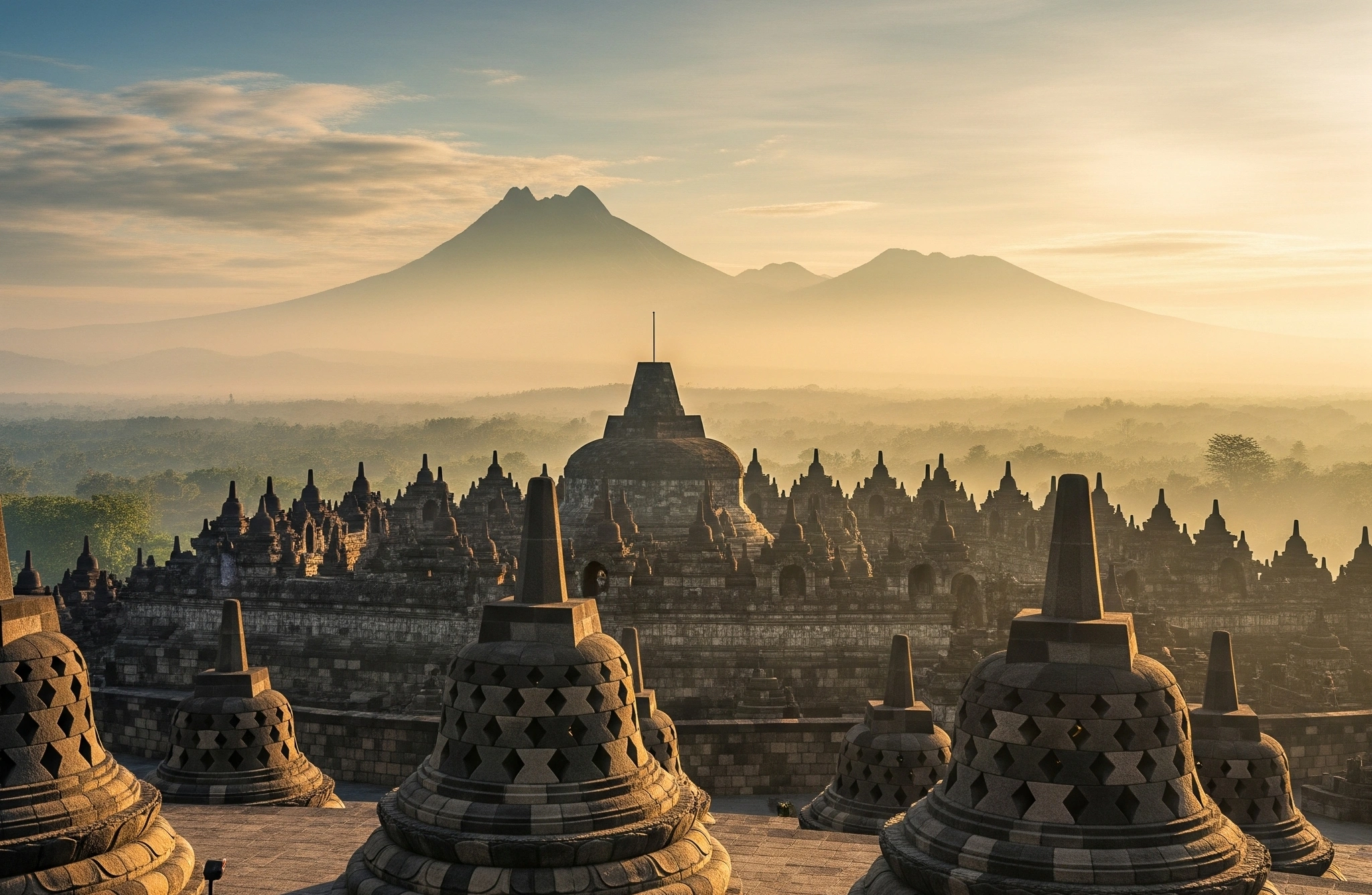Imagine a land where towering volcanoes breathe fire and life, and ancient temples rise in perfect harmony with the earth’s contours. In our modern world, we often view nature and human creations as separate entities. However, in Java, they are profoundly intertwined. This article unveils the deep connection between Java’s magnificent temples and its powerful natural environment, particularly its volcanoes. We will explore how these structures are not just architectural marvels but integral parts of the sacred landscapes of Java. This isn’t about superstition; instead, it’s a journey into profound ecological and spiritual wisdom. It reveals a symbolic interpretation of humanity’s ancient relationship with powerful natural forces.
Table of Contents
- The Cosmic Embrace: Understanding Java’s Sacred Landscapes
- Volcanoes as Deities: Unveiling the Sacred Patterns
- Borobudur and Prambanan: Temples Woven into the Earth’s Fabric
- Reconnecting with Nature’s Wisdom: Practical Steps for Modern Life
- Ancient Harmony for Modern Challenges: The Timeless Relevance
- The Enduring Dialogue: Humanity and the Earth
The Cosmic Embrace: Understanding Java’s Sacred Landscapes
In Java, the concept of a “sacred landscape” extends beyond mere geographical features. It signifies a profound integration of human spiritual endeavors with the natural environment, particularly its powerful volcanic mountains. Ancient Javanese civilizations viewed the land as alive, imbued with spiritual energy. Therefore, the temples they built were designed to harness and reflect this inherent sacredness.
Origins of Sacred Landscape Beliefs
The roots of this reverence lie in ancient animistic beliefs. These traditions predated the arrival of Hinduism and Buddhism. Indigenous beliefs held that mountains, especially volcanoes, were abodes of powerful spirits and ancestors. When Hindu-Buddhist philosophies arrived, they seamlessly integrated with these existing beliefs. The concept of the *axis mundi*, or cosmic axis, found a natural manifestation in Java’s towering volcanoes. This symbolized a connection between the earthly and celestial realms.
Early Javanese kings and spiritual leaders meticulously chose temple sites. They sought locations that were not only strategically sound but also spiritually potent. Often, these sites were at the foot of volcanoes or along sacred riverbanks. The foundational principle was one of harmony with nature. Here, human creations mirrored the grand design of the cosmos. Temples were built as micro-cosmos, reflecting the macro-cosmos of the universe and the sacred mountain. This approach reveals a deep respect for nature’s power and wisdom. It is not a literal belief in gods residing in volcanoes. Instead, it serves as a guide for understanding humanity’s profound connection to its environment.
Volcanoes as Deities: Unveiling the Sacred Patterns
Java’s landscape is dominated by a chain of volcanoes. These geological giants have played a central role in shaping the island’s spiritual and cultural identity. They are not just mountains; indeed, they are living entities, revered as sources of both life and destruction. They embody powerful sacred patterns.
Mount Merapi: The Fiery Heart of Java
The Fiery Heart: Creator and Destroyer
Mount Merapi, one of the world’s most active volcanoes, stands as a prime example of a sacred mountain. Its constant activity, marked by eruptions and tremors, is seen as a manifestation of divine power. Merapi is revered as the dwelling place of spirits, including the mythical guardian, Kyai Sapujagad. Rituals and offerings are regularly performed to appease the mountain. This ensures its benevolence for agricultural fertility and protection. This duality—its capacity for both devastating destruction and life-giving fertility (through volcanic ash enriching the soil)—highlights the profound respect and fear it inspires.
Rivers and Springs: Veins of Life and Purification
Veins of Life: Sacred Waters
Rivers and springs originating from the volcanic highlands are considered sacred veins of life. They provide essential irrigation for rice paddies, sustaining the population. Many ancient temples, such as Tirta Empul, were built near natural springs. These served as holy bathing sites for purification rituals. The flow of water symbolizes continuity, cleansing, and spiritual renewal. While water brings life, it also possesses the power to erode, representing another duality in nature’s force.
Caves and Forests: Realms of Meditation and Mystery
Realms of Seclusion: Inner Journeys
Beyond the peaks, Java’s caves and dense forests also hold sacred significance. Caves often served as secluded retreats for meditation and spiritual practice. They provided a quiet space for introspection and communion with nature. Forests, meanwhile, were considered mystical realms, home to diverse flora and fauna. Sometimes, people believed they harbored unseen entities. They were sources of medicinal plants and natural resources, but also places of mystery and the unknown. These natural features provided the perfect backdrop for spiritual seekers, offering both shelter and a challenging environment for inner growth.
Borobudur and Prambanan: Temples Woven into the Earth’s Fabric
Java’s most iconic temples, Borobudur and Prambanan, are not simply architectural wonders. They are masterworks of integration. They were designed to be in profound dialogue with their surrounding natural landscapes, especially the volcanic peaks that define Central Java.
Borobudur: A Cosmic Mountain Amidst Volcanic Giants
Borobudur, the world’s largest Buddhist temple, was built around the 9th century CE. It stands as a monumental representation of the Buddhist cosmos. Its location is far from accidental. It rises from a natural hill, strategically positioned within a basin surrounded by four volcanoes: Merapi, Merbabu, Sumbing, and Sindoro. The temple’s tiered structure itself mimics a cosmic mountain, a human-made peak reflecting the natural ones that frame it. The “Aha!” moment for many visitors comes when they realize the temple is not just *on* the landscape but *is* the landscape. It represents a spiritual journey ascending through realms, mirroring the physical ascent of a mountain. The temple’s orientation and design align with these natural features. This demonstrates a deep understanding of sacred geometry and the integration of human creation with the powerful forces of nature.
Prambanan: A Hindu Ode to Balance and Prosperity
Prambanan, Indonesia’s largest Hindu temple complex, was constructed shortly after Borobudur. It stands majestically on a fertile plain, framed by the very same volcanic backdrop. While Borobudur embodies the cosmic mountain, Prambanan’s tall, pointed spires echo the sharp peaks of the surrounding volcanoes. Its strategic location in a rich agricultural area symbolizes the balance between divine power (represented by the mountains) and earthly prosperity (nurtured by the volcanic soil and rivers). The temple complex, dedicated to the Trimurti, reflects a Hindu worldview where deities are often associated with natural phenomena. Its design and placement underscore the ancient Javanese belief that human spiritual endeavors should be in harmonious relationship with the powerful, sacred forces of nature.
Reconnecting with Nature’s Wisdom: Practical Steps for Modern Life
The ancient Javanese understanding of sacred landscapes offers profound lessons for our modern lives. In an age of increasing urbanization and digital immersion, reconnecting with nature’s wisdom is crucial for well-being. Understanding isn’t enough; real transformation requires concrete action. The principles that guided the placement and design of Java’s temples can inspire our own journey toward greater harmony with the natural world.
Mindful Observation of Natural Cycles
Practice: Consciously observe the natural world around you. Pay attention to the phases of the moon, the changing seasons, the patterns of weather, and the behavior of local flora and fauna.
Application: Keep a simple nature journal, noting your observations. Practice outdoor meditation or simply sit quietly in a park or garden. Allow yourself to be present with nature. Take a moment each day to look at the sky.
Philosophical Meaning: This practice helps you realign with natural rhythms. It fosters patience, acceptance, and a sense of belonging within the larger ecological system. It’s about recognizing the subtle wisdom nature offers.
Creating Sacred Spaces in Your Environment
Practice: Designate a small area in your home, office, or garden as a personal sacred space. This doesn’t require grand gestures; it just needs intention.
Application: Use natural elements like a small plant, a smooth stone, a bowl of water, or a simple candle. Keep this space clean, uncluttered, and dedicated to quiet reflection, meditation, or simply finding a moment of peace.
Philosophical Meaning: By consciously creating a sacred space, you bring the essence of the grand Javanese landscapes into your daily life. It provides a consistent reminder of the importance of inner peace and connection. It becomes a personal sanctuary.
Engaging with Local Ecosystems
Practice: Learn about the specific natural environment where you live. Understand its unique ecosystems, native plants, and wildlife. Consider how your actions impact this local environment.
Application: Visit local nature preserves or parks. Participate in community clean-up initiatives or support local conservation efforts. Reduce your ecological footprint by making conscious choices about consumption and waste.
Philosophical Meaning: This fosters a deeper sense of interconnectedness and responsibility towards the earth. It echoes the reverence of ancient builders who understood their existence was intrinsically linked to the health and vitality of their natural surroundings.
Ancient Harmony for Modern Challenges: The Timeless Relevance
The profound relationship between temples and nature in ancient Java offers crucial insights for navigating the challenges of our contemporary world. In an era grappling with climate change, rapid urbanization, and a growing disconnect from the natural world, the wisdom embedded in Java’s sacred landscapes is more relevant than ever.
The ancient Javanese understood that human well-being was intrinsically linked to the health of their environment. This holistic perspective can inform our modern approach to ecological stewardship. It promotes sustainable living and a deeper appreciation for biodiversity. Furthermore, in an age of pervasive stress and mental health concerns, reconnecting with nature, as exemplified by the temple builders, offers tangible benefits. Spending time in natural environments, even urban green spaces, has been shown to reduce stress, improve mood, and enhance cognitive function. The temples stand as a timeless reminder that integrating human life with the natural world fosters not only spiritual grounding but also resilience and overall well-being.
 The Enduring Dialogue: Humanity and the Earth
The Enduring Dialogue: Humanity and the Earth
They stand as powerful symbols of a civilization that understood and revered the natural forces shaping its existence. By recognizing the profound connection between these sacred structures and their volcanic landscapes, we gain a deeper appreciation for ancient wisdom. This wisdom teaches us the importance of harmony, respect, and integration with the natural world. It reminds us that our greatest achievements often arise when we work in concert with, rather than against, the powerful forces of nature.
“Look deep into nature, and then you will understand everything better.”
— Albert Einstein
Call to Action
Uncover the spiritual power of nature and ancient sites!
Context and References
Internal Links to Related Articles:
- Read more about the history of ancient Javanese kingdoms.
- Explore the symbolism of mountains in world religions.
- Discover the principles of ecological architecture.
External References (If Applicable):
- UNESCO World Heritage Centre: Borobudur Temple Compounds
- UNESCO World Heritage Centre: Prambanan Temple Compounds
- Britannica: Java – History
- National Geographic: Volcanoes
Disclaimer:
This content is provided for cultural and ecological understanding. It explores the historical and spiritual significance of natural landscapes in Javanese tradition, emphasizing human connection and reverence for nature, rather than literal interpretations of divine intervention.
About the Author/Source:
This ecological and spiritual insight is shared by The Guardian of Sacred Sites — a symbolic figure representing deep respect for nature, cultural heritage, and environmental harmony. These writings are meticulously crafted by the [Your Website Name] team, comprised of cultural researchers, ecologists, and spiritual practitioners dedicated to preserving and translating ancient wisdom into a relevant format for contemporary generations. We believe that ancestral heritage is not merely a relic, but a compass for living in harmony with our planet. Each article is written through a process of extensive research, expert consultation, and deep contemplation, to ensure accuracy and the profound nobility of its contained values. Learn more about our authors and philosophy.
